Peculiar Planets
The formal definition of a planet was last discussed by the International Astrophysical Union in 2006. The resulting decision - that a planet should orbit a primary star, be massive enough to have settled into a sphere under gravity, and to have cleared its neighbourhood of other comparable bodies through accretion or dynamical interaction - caused a certain amount of controversy at the time, but is now generally accepted. However science fiction has explored a range of other planetary bodies, of more or less scientific plausibility.
Pancake planets
One widely known fact about planet Earth is that it is slightly flattened at the poles - more the shape of an apple than a ping-pong ball. This shape, technically known as an oblate spheroid, is the result of Earth’s spin around the axis running from the North to South pole. That spin acts as an outwards force from the equator, in the same way that material attempts to fly outwards when whirled on the end of a string. This force somewhat balances gravity, distorting the surface shape. A number of authors have considered planets in which this distortion is taken to an extreme.
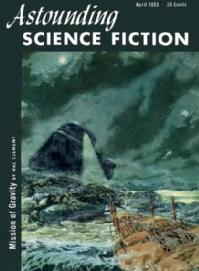 Perhaps the best known, and best realised, of such worlds is the planet Mesklin in the novel Mission of Gravity by Hal Clement (first published in Astounding SF in 1953). In this story, an Earth scientific mission is forced to recruit the aid of a merchant trader native to the planet in order to recover a lost scientific probe. As rapidly becomes clear, Mesklin is a rapidly rotating world, which experiences about 90 days in a single twenty-four of our hours, and which thus bulges to the extent that its pole-to-pole diameter is less than half that of the equator. As a result, while humans can survive (with assistance) in the 3g (three Earth-gravity) environment of the equator, they cannot come close to enduring the 700 gravities of the pole, where the rocket landed. The narrative follows the expedition half way around this world from the viewpoint of the indigenous trader, whose form approximates that of a centipede, long, low-lying, with a robust shell, multiple legs and pincers.
Perhaps the best known, and best realised, of such worlds is the planet Mesklin in the novel Mission of Gravity by Hal Clement (first published in Astounding SF in 1953). In this story, an Earth scientific mission is forced to recruit the aid of a merchant trader native to the planet in order to recover a lost scientific probe. As rapidly becomes clear, Mesklin is a rapidly rotating world, which experiences about 90 days in a single twenty-four of our hours, and which thus bulges to the extent that its pole-to-pole diameter is less than half that of the equator. As a result, while humans can survive (with assistance) in the 3g (three Earth-gravity) environment of the equator, they cannot come close to enduring the 700 gravities of the pole, where the rocket landed. The narrative follows the expedition half way around this world from the viewpoint of the indigenous trader, whose form approximates that of a centipede, long, low-lying, with a robust shell, multiple legs and pincers.
As a science teacher and writer of hard (i.e. scientifically accurate and driven) science fiction, Clement took the task of building a scientifically plausible world seriously, to the extent that he published an article on the subject in the June 1953 issue of Astounding Science Fiction magazine, alongside the third of four instalments of his novel. This article, Whirligig World, summarises Clement’s approach to writing hard SF:
“The fun, and the material for this article, lies in treating the whole thing as a game. I’ve been playing the game since I was a child, so the rules must be quite simple. They are; for the reader of a science-fiction story, they consist of finding as many as possible of the author’s statements or implications which conflict with the facts as science currently understands them. For the author, the rule is to make as few such slips as he possibly can.”
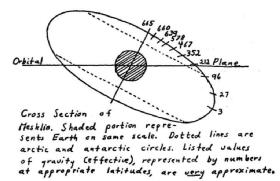 He explains that the story was inspired by then-recent observations of the 61 Cygni system which suggested that the system might host a planet with a mass of 16 Jupiters, in a four year elliptical orbit around the binary sun. Features of the planet follow from this, including the idea that the planet’s steep gradient in atmospheric density leads to the optical illusion that the inhabitants’ world is the concave interior of a shallow bowl, rather than the domed exterior of a flattened spheroid. The existence of a super-Jovian 61 Cygni C has since been disproved, but the story and associated article stand as an impressive example of astronomically-inspired and scientifically rigorous world-building.
He explains that the story was inspired by then-recent observations of the 61 Cygni system which suggested that the system might host a planet with a mass of 16 Jupiters, in a four year elliptical orbit around the binary sun. Features of the planet follow from this, including the idea that the planet’s steep gradient in atmospheric density leads to the optical illusion that the inhabitants’ world is the concave interior of a shallow bowl, rather than the domed exterior of a flattened spheroid. The existence of a super-Jovian 61 Cygni C has since been disproved, but the story and associated article stand as an impressive example of astronomically-inspired and scientifically rigorous world-building.
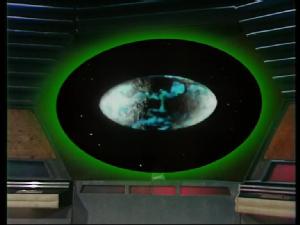 A similarly ellipsoidal planet can be found in the 1980s television series Blake’s 7 (BBC TV, 1978-1981). In the third season finale episode “Terminal”, Avon, the leader of the eponymous rebel band, follows a set of instructions which take him to a point in space where he finds the planet Terminal. Like Mesklin, this world is heavily distorted from a simple sphere, with an equatorial radius about twice the polar one. However unlike Mesklin, Terminal is an artificially created world, originally designed as an experiment in building a self-sustaining biosphere, but long since believed destroyed. It eventually proves to have been coopted by the authoritarian Federation as a secret base for experimentation.
A similarly ellipsoidal planet can be found in the 1980s television series Blake’s 7 (BBC TV, 1978-1981). In the third season finale episode “Terminal”, Avon, the leader of the eponymous rebel band, follows a set of instructions which take him to a point in space where he finds the planet Terminal. Like Mesklin, this world is heavily distorted from a simple sphere, with an equatorial radius about twice the polar one. However unlike Mesklin, Terminal is an artificially created world, originally designed as an experiment in building a self-sustaining biosphere, but long since believed destroyed. It eventually proves to have been coopted by the authoritarian Federation as a secret base for experimentation.
No explanation for its distorted shape (e.g. rotation) is mentioned in the script, and it’s hard to see why anyone would choose to construct such an unstable world-shape as a static ellipsoid through choice. This likely reflects the relatively low priority placed on scientific precision in this series relative to its other social and moral themes.
Doughnuts in Space.
Another possible planetary morphology (shape) that has long excited interest is the idea that a planet may be toroidal - that is, shaped like a ring donut - rather than spherical. Such a system was analysed by Poincaré, Dyson and others in the late nineteenth century, and continues to attract analyses in the scientific literature to date. As these authors have shown, a toroidal mass is potentially somewhat stable against collapse to a sphere as long as it is spinning, and either has a primary star placed along its axis (on a line passing through the doughnut hole) or no star at all. In its simplest form, the gravitational balance is the same that underlies models for wheel-shaped megastructures, space stations or ringworlds. As a result, it might theoretically be possible for a planet of this form to exist.
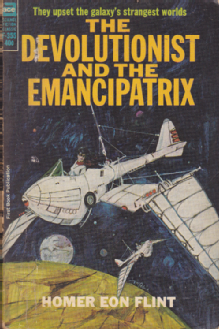 An early example of a ring-planet in science fiction can be found in The Emancipatrix (1921), a novella by Homer Eon Flint which forms part of a series in which a small group of humans explore other worlds and encounter a range of thought experiments into societal development and optimal government. In the later stories, including this, the travel is accomplished through means of a telepathic projection [1], which allows the explorers to see through the eyes of an individual on the target planet, without the knowledge of their “agent”. In The Emancipatrix, the explorers encounter Sanus, a world orbiting Arcturus on which humanity is subjugated by a sentient race of bees and controlled by the threat of their venomous stings. The first suggestion that the world’s morphology may be outside the norm is seen when one of the agents is lying outside at night:
An early example of a ring-planet in science fiction can be found in The Emancipatrix (1921), a novella by Homer Eon Flint which forms part of a series in which a small group of humans explore other worlds and encounter a range of thought experiments into societal development and optimal government. In the later stories, including this, the travel is accomplished through means of a telepathic projection [1], which allows the explorers to see through the eyes of an individual on the target planet, without the knowledge of their “agent”. In The Emancipatrix, the explorers encounter Sanus, a world orbiting Arcturus on which humanity is subjugated by a sentient race of bees and controlled by the threat of their venomous stings. The first suggestion that the world’s morphology may be outside the norm is seen when one of the agents is lying outside at night:
“For he saw a broad band of sky, as broad as the widest part of the Milky Way, which was neither black nor sparkling with stars, but glowing as brightly as the full moon! From the eastern horizon to the zenith it stretched, a great "Silvery Way," as Van Emmon labeled it; and as the darkness deepened and the night lengthened, the illumination crept on until the band of light stretched all the way across. Van Emmon racked his brains to account for the thing.”
Eventually one of their agents flees across a bizarre and barely-habitable interface region into a completely new land in which the bees are not sentient and humanity has fought itself to extinction through a series of class wars. The weird behaviour of gravity in the boundary region give the explorers the explanation, with one man comparing the situation to passing from the inner to the outer face of a golden wedding band worn to a thin sharp edge:
"An annular world!" exclaimed the doctor, his eyes sparkling delightedly. "It confirms the nebular hypothesis!"
"How so?" Smith wanted to know.
"Because it proves that the process of condensation and concentration, which produces planets out of the original gases can take place at uneven speeds! Instead of concentrating to the globular form, Sanus cooled too quickly; she concentrated while she was still a ring!"
Unfortunately, while scientific evidence still favours the formation of planets from a nebula surrounding the young Sun, this particular variant of it lacks plausibility. Forming such a planet is outside the possible scope of our current theories of protoplanetary disk evolution, and, if it could be formed, the resulting planet would be very unstable to perturbations from off axis (such as those from other planets in the solar system, binary companions of the host star or other large bodies). Perhaps the closest analogue in current planet formation theory is synestia, a hypothesised doughnut-shaped ring of gas and dust which may have existed in the early stages of the formation of the Earth-Moon system, but which soon condensed into the two separate spheres.
Despite this, authors have continued to explore doughnut-shaped worlds. While the best known is the artificial megastructure Ringworld, described extensively in a series of novels by Larry Niven (beginning 1970), this is a solar-system-scale slice of a Dyson sphere which bears little if any resemblance to a planetary-scale environment. Similarly, the tiny toroidal asteroid known as Kobold in Larry Niven’s novel Protector (1974) has been engineered by an advanced intelligence, but falls far short of planetary size.
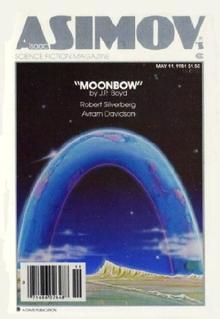 On a more planetary scale, we find the world described in “Moonbow” by atmospheric physicist John P. Boyd (short story, published in Asimov’s SF, May 1981). The story begins with an entry in the ship’s log of the discoverer:
On a more planetary scale, we find the world described in “Moonbow” by atmospheric physicist John P. Boyd (short story, published in Asimov’s SF, May 1981). The story begins with an entry in the ship’s log of the discoverer:
“Imagine a planet in the shape of a doughnut, a ring wide enough to reach from Earth to Earth’s moon, but only a hundred of that thick. Spin this torus so as to make its nights the length of two earthly nights and its days the span of two terran days, and then the centrifugal force will exactly balance the tendency of the ring to contract into a sphere. This is the world that I have found.”
Like the similar ring in The Emancipatrix, the opposite side of this planetary body is illuminated by the sun during local night as seen from the inner surface, producing:
“an arch of light, coloured with patches of cloud-mantled seas and whimsically-shaped continents, it extended from the zenith halfway down to both the eastern and western horizons, a hybrid of moon and rainbow.”
However unlike the explorers in Flint’s novella, the crash-landed explorer in Boyd’s “Moonbow” has no doubt from the first that this planet was artificially constructed in some distant past. His thousand-kilometre journey to find the distant beacon he needs to summon aid is accompanied by an equally important search for understanding - of who built the world and why. In fact, the answers, together with the reasons for his crash, are rooted in a simple but surprising observation made in the story. Local gravity from a ring of this kind will not act like that of a solid mass but rather like that from an infinite flat sheet - mathematically this means that the gravity doesn’t fall off with change of height squared, but rather just with the change of height (i.e. as 1/r rather than 1/r2 as on Earth). In the story, this shallow gravity gradient allows the ring to retain a dense atmosphere, despite its low mass, and also makes flying an efficient and easy form of travel.
Of course, not every realisation of a ring-world in science fiction demonstrates an equally thorough respect for scientific plausibility. An interesting example of the use of toroidal planets for their visual impact and excitement can be found in the 1960s comic adventure Zero-X (comic, 1967-1969). Originally a spin-off from the 1965-6 Thunderbirds television series and its 1966 feature-length film Thunderbirds Are Go, the colour strip diverged substantially from this source as it followed the adventures of the titular exploration craft and her crew over full-pages of the TV Century 21 magazine.
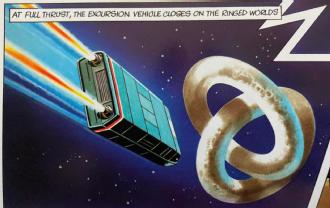 In one adventure, most often described as "Prisoners of the Eye-Leaves" (June-August 1969, written by Angus Allan and illustrated by Mike Noble, note: the stories were originally unnamed), the crew investigate a newly discovered system which is described as hosting “freak ringed planets”, “uncanny” or “siamese-twinned worlds”. In fact the planet consists of two interlocked rings, with vegetation and a breathable atmosphere on the inner surface of the link area. The origin of this bizarre world, or why the planet’s vegetable life appears to have evolved to control a hypothetical animal life it doesn’t possess, is left unexplained, as the crew simply fight to escape. The system is, needless to say, wildly implausible from a scientific point of view, but certainly makes for striking and memorable imagery.
In one adventure, most often described as "Prisoners of the Eye-Leaves" (June-August 1969, written by Angus Allan and illustrated by Mike Noble, note: the stories were originally unnamed), the crew investigate a newly discovered system which is described as hosting “freak ringed planets”, “uncanny” or “siamese-twinned worlds”. In fact the planet consists of two interlocked rings, with vegetation and a breathable atmosphere on the inner surface of the link area. The origin of this bizarre world, or why the planet’s vegetable life appears to have evolved to control a hypothetical animal life it doesn’t possess, is left unexplained, as the crew simply fight to escape. The system is, needless to say, wildly implausible from a scientific point of view, but certainly makes for striking and memorable imagery.
Rocheworlds
Staying with twinned worlds, but this time perhaps more plausible ones, we find the concept of binary planets. There are many examples of wide binary planets in science fiction that are essentially two neighbouring but separate worlds. However a subset of fictional twin worlds don’t just orbit their common centre of mass but either make contact with one another or are sufficiently close to cause significant distortion.
Returning to Homer Eon Flint’s series of interplanetary explorations, before arriving at Sanus, the same group spent some time exploring Capellette, a planetary body in the Capella system in The Devolutionist (novella, 1921) . The society on this planet is highly class-stratified, with a small, autocratic Commission controlling a vast workforce, and ensuring that both their information sources and education strongly reinforce the status quo. To their surprise, two characters observe pendulums of equal length swinging at different rates at different locations, and infer a 50 percent variation in the planet radius from one place to another, suggesting that the planet may be flattened or ellipsoidal. However a little later, a character’s agent travels to a shadowed region in which a cliff appears first to lie ahead, and then to hang directly overhead.
“Whereupon the athlete, without another word, pulled his cap down tight, made sure his pockets were buttoned, cleared the shrubbery away from his feet and—leaped! Leaped straight into the air, and as he went up, he flipped his body as only an acrobat can, so that he turned a mid air somersault.
But he did not come back to where he jumped from. Instead, his jump took him five yards, which separated the ground from the roof; and when he landed HIS FEET WERE RESTING ON THE ROOF, AND HIS HEAD WAS POINTING DOWNWARD, TOWARD MONA.”
After this, it is clear that Capellette is actually a binary planet, in which two near-spherical bodies are within metres of making contact, and share a common atmosphere, so that characters can jump from one to another, or easily fly between them using abundant ornithopters.
In keeping with the social commentary themes of the story (which are inevitably mired in their own contemporary cultural assumptions), we soon learn that the two bodies are known as Hafon (rural and parkland, sparsely occupied by the leisured and ruling classes) and Holl (industrial and overcrowded). Perhaps unsurprisingly, the names translate as their near-cognates: Heaven and Hell. The story follows an attempted uprising - and an engineering project which has potential consequences for the future of the entire binary planet. The contact-binary nature of the planet is never explicitly connected to the surface gravity variation. While it’s tempting to suggest that each planetoid is distorted by the other, as in the cases below, it seems more likely that the two different pendulum oscillation rates were originally measured on the two different worlds, which are not perfect twins. This is all the more likely since, in the absence of rapid rotation, the surface of a gravitationally-distorted world should experience the same pendulum swing over its surface, regardless of its changing radius.
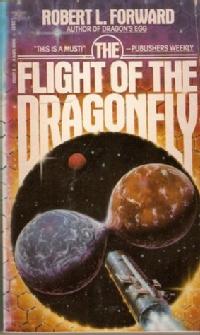 A more scientifically developed picture of a very close binary planet can be found in Robert Forward’s novel Rocheworld (1984) and its sequels [2].
A more scientifically developed picture of a very close binary planet can be found in Robert Forward’s novel Rocheworld (1984) and its sequels [2].
When two bodies lie in close proximity, the local gravitational field is distorted into a figure of eight configuration, in which each loop is an ellipsoidal or teardrop-like distorted sphere which marks the Roche lobe, a contour beyond which material would fall away from the body, rather than remain bound to it. This altered shape is often seen, for example, in very close or contact binary stars, where the orbit alternately rotates the distorted star so that it appears larger or smaller from our perspective - and hence brighter or fainter [3].
In Rocheworld, Barnard’s Star (one of our closest neighbours, a red dwarf located just six light years away) is described as having two significant planets - the super-Jovian Gargantua, a gas giant whose moons are themselves planet-sized bodies, and the titular Rocheworld. This consists of a binary planet whose components - named Roche and Eau - come within 50 miles of contact. As a result, both are highly distorted, and the pair share an atmosphere. As the names suggest, Roche (French for rock) is arid and rocky, while Eau (French for water) has ended up with most of the water in the system (due to the slight difference in mass and density between the lobes), and virtually its entire surface is covered in ocean. On crash-landing in the water, a crew of human explorers discover that this ocean is in fact inhabited, and the crew must both negotiate with the indigenous life and navigate the complex geometry of the planet in order to return to their base. This situation is further complicated by periapsis (i.e. close approach to the primary star) in Rocheworld’s elliptical orbit, and the associated gravitational and tidal stresses on the system.
In common with many scientist-authors, Forward has clearly modelled the physics of his world in geat detail, and was keen to present that to his readers. Where Clement published a separate article (Whirligig World) on Mesklin, Forward included his analysis of orbital and gravitational dynamics as an appendix to the 1990 version of the novel, formatted as a report to an Earth government body summarising the system’s properties.
Bizarre Worlds
While spheres, pancakes, ellipses, roche-worlds and even toroids are at least vaguely plausible as gravitationally-stable planets, that hasn’t stopped science fiction writers speculating about other, far less likely shapes and their implications for their inhabitants.
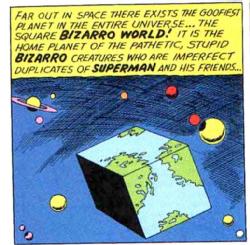 A planet in the form of a cube formed the basis of Htrae, the central planet of Bizarro World, a parallel-universe spin-off of the Superman comics in the DC universe which first appeared in 1960. In this case, the cubic form is the result of a deliberate action by Superman himself, who offered to square off the planet to increase its differentness from Earth. Since the Bizarro mirror world inhabitants pride themselves on doing everything opposite to our universe, it’s perhaps unsurprising that they accepted the offer, and even that their world apparently works differently under gravity too.
A planet in the form of a cube formed the basis of Htrae, the central planet of Bizarro World, a parallel-universe spin-off of the Superman comics in the DC universe which first appeared in 1960. In this case, the cubic form is the result of a deliberate action by Superman himself, who offered to square off the planet to increase its differentness from Earth. Since the Bizarro mirror world inhabitants pride themselves on doing everything opposite to our universe, it’s perhaps unsurprising that they accepted the offer, and even that their world apparently works differently under gravity too.
A similar premise - deliberately knocking the edges off our own world to make a cube - can be found elsewhere. “Cubeworld” by Henry H Gross is a thought-experiment in an amusing short story that appeared in Mathenauts: Tales of Mathematical Wonder (anthology, 1987, edited by Rudy Rucker). The premise is simple: in order to avoid a chaotic perturbation to the Solar System caused by a passing massive object, the Earth must be engineered into a cube shape, and then, a few years later, internal stresses require it to be transformed back to a sphere. Each transformation is accomplished within a month, while the population and biosphere (which miraculously survives) migrates en masse! While neither the logic behind the transformation nor the practical method bears close inspection (and isn’t meant to), the story is still a fun exploration of how such modification would affect Earth. In particular, it describes the changes in land usage and society that results from the relocation. Another interesting aspect that is explored in the story is the psychological effects of not having a surface perpendicular to the (still radial) force of gravity:
“So, while our surveyors jubilantly certified our world euclideanly planar, it felt as though we were about to slide along the inside of a bowl towards its center, where, needless to say, the ocean has long since flowed and above which it now hovered, a jiggling bubble several miles high and 3500 miles in diameter, one of six such bodies of water. Because Cubeworld felt steep, within minutes our planet looked steep as well. Though our horizon was straight, we felt it as bowed, and soon we began to “see” it that way too.”
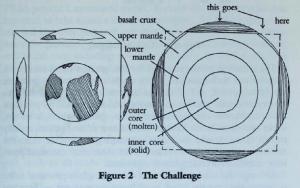 Cube-Earth thus ends up with oceans collected at the centre of each face (where gravity is strongest), and the human occupants perceive the technically flat sides as curved, largely because our perceptions are evolved to see the Earth’s genuine curves as flat. Local gravity is not perpendicular (i.e. extending straight up) from any face, which results in trees that grow at a slant, and transport networks designed to take advantage of the apparent local slopes as they travel along the flat faces of the cube. The story is accompanied by a number of diagrams which demonstrate both the ludicrousness of the underlying premise and the counter-intuitive consequences of this extreme geo-engineering.
Cube-Earth thus ends up with oceans collected at the centre of each face (where gravity is strongest), and the human occupants perceive the technically flat sides as curved, largely because our perceptions are evolved to see the Earth’s genuine curves as flat. Local gravity is not perpendicular (i.e. extending straight up) from any face, which results in trees that grow at a slant, and transport networks designed to take advantage of the apparent local slopes as they travel along the flat faces of the cube. The story is accompanied by a number of diagrams which demonstrate both the ludicrousness of the underlying premise and the counter-intuitive consequences of this extreme geo-engineering.
Another author to explore a cube-world was G. David Nordley who published his novellete To Climb a Square Mountain in Analog magazine in November and December 2009. As in several of the cases above, Nordley’s protagonists crash land on the wold - a common trope that forces the human characters to explore the landscape, flora and fauna first hand. However unlike the other cases here, the main character Jacques Song initially has no idea of the surprising geometry of the new planet, simply waking from a prolonged period in a cold sleep unit to discover that the ship carrying him and others had already crashed on what initially appeared to be a normal planet of a red dwarf star.
It gradually becomes clear that this world is an engineered alien megastructure, with the cube form trapping a bubble of air in the centre of each face, while the edges and corners (which appear from ground level to be mountains since local gravity follows a curve rather than the plane) extend out of the atmosphere. Indeed, the world appears to have been designed to isolate the six biospheres on its faces from one another, with the only access between them through space or tunnels interior to the cube’s corners. Unlike some of the other cases above, this story focuses on interpersonal and religious conflicts, as well as the struggle for survival, rather than the origin and nature of the planet - much of which is elucidated in a somewhat deus-ex-machina exposition dump towards the end of the text.
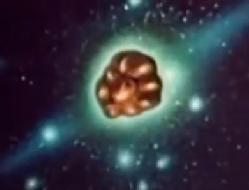 Moving from the geometric to the simply bizarre, continuing the tradition of the comic book worlds in using odd planets for visual impact, we find the animated television series Battle of the Planets (Sandy Frank Productions animation, 1978). Adapted from the Japanese anime Science Ninja Team Gatchaman (Tatsunoko productions, anime, 1972-1974), the series was rescripted and new plots developed from the original footage, with additional western-style animation interpolated to pad out the run time and provide additional exposition. In the process, the series was redefined from an Earth-bound fight against a very human enemy with an alien influence in the background (which was the premise of Gatchaman) to an interstellar fight against an alien horde (the premise of Battle of the Planets) which better aligned with the then-fashionable space opera sub-genre popularised by Star Wars (film, 1977). It’s fair to say that scientific accuracy was not a high priority during the adaptation, and the planet imagery added (and reused for several different worlds) owed more to the imagination than astronomical theory. The planet Riga (and, apparently, also Leucadia, and Mir, and Vega, and Spectra, and Tramulus…) is portrayed by a very odd multi-lobed shape which either indicates that these planets have some kind of organic structures, or that the worlds have been heavily engineered, or that the spaceship viewscreen is strangely affected by the Time Warp used for faster than light travel, or, more likely, that the animators just felt it looked exciting.
Moving from the geometric to the simply bizarre, continuing the tradition of the comic book worlds in using odd planets for visual impact, we find the animated television series Battle of the Planets (Sandy Frank Productions animation, 1978). Adapted from the Japanese anime Science Ninja Team Gatchaman (Tatsunoko productions, anime, 1972-1974), the series was rescripted and new plots developed from the original footage, with additional western-style animation interpolated to pad out the run time and provide additional exposition. In the process, the series was redefined from an Earth-bound fight against a very human enemy with an alien influence in the background (which was the premise of Gatchaman) to an interstellar fight against an alien horde (the premise of Battle of the Planets) which better aligned with the then-fashionable space opera sub-genre popularised by Star Wars (film, 1977). It’s fair to say that scientific accuracy was not a high priority during the adaptation, and the planet imagery added (and reused for several different worlds) owed more to the imagination than astronomical theory. The planet Riga (and, apparently, also Leucadia, and Mir, and Vega, and Spectra, and Tramulus…) is portrayed by a very odd multi-lobed shape which either indicates that these planets have some kind of organic structures, or that the worlds have been heavily engineered, or that the spaceship viewscreen is strangely affected by the Time Warp used for faster than light travel, or, more likely, that the animators just felt it looked exciting.
Interpreting Peculiar Planets
Most of the fiction involving peculiarly shaped planets recognises their sheer unlikeliness, leaning on the possibility of artificial engineering or - rarely - sheer freak happenstances. So why is this theme popular amongst SF writers, particularly those with a scientific background of their own?
Well, in the first place, of course, these planets provide a novel and potentially interesting setting for storytelling. In the same way as thought-experiment worlds in which the nature of the universe itself is changed, they allow for a logical exercise in world-building and a subsequent exploration of the consequences of the resulting construct. Since those consequences often contrast to any we can experience directly, they provide the advantage of novelty and an opportunity to build interesting characters whose perceptions and life experience differs from our own. In doing so they enable writers an opportunity to build truly alien characters with alien worldviews, and tell original stories using them. At the same time such exercises challenge readers to question whether they would recognise or accept such alien intelligences if they were encountered in our own world, and by extension question the assumptions that underlie our definitions of humanity and intelligences itself.
Such stories, and associated texts such as the Whirligig World article by Hal Clement or the appendix to Rocheworld, also provide an avenue for science education regarding the nature of the planets and the nature of gravity itself, or to communicate and engage with current results in astrophysics - although, as is so often the case in science fiction, the science is frequently compromised for the sake of the fiction in all but the hardest SF. An interesting feature here is how often these unusual planets are shown as orbiting red dwarfs. Stars less massive and cooler than the Sun are actually much more common in the Milky Way, and have the narratively-useful feature that their habitable zones are much closer to the star than in our Solar System. As a result, the year for red dwarf planets is very short, and lets the peculiarities of the planet’s orbit (e.g. elliptical orbits, tidal distortions) be played out on a narrative timescale of weeks or a few months rather than (Earth) years or decades.
In some cases, as is the case for Cubeworld, The Devolutionist and The Emancipatrix, for example, the geometric distortion is used as an analogy or parallel for the writer’s own concerns. Both Gross and Flint were writing satires and commentary on their contemporary society and its potential developments. By creating worlds as truly different as the cuboid Earth, Capellette and Sanus, they could engage readers with the story without triggering any instinctive defensiveness which might otherwise prevent their messages getting across.
Perhaps most obviously though, as the examples from Zero-X, Battle of the Planets and Blake’s 7 demonstrate, peculiar planets are visually impactful signposts - they tell the viewers to sit back, be ready to suspend their disbelief and enjoy the upcoming adventure, which will take them, quite literally, out of this world.
"Peculiar Planets", Elizabeth Stanway, Cosmic Stories blog, 11th March 2024.
Notes:
[1] Exploration via psychic projection was a fairly common trope before the advent of rocket travel, with other examples including the Barsoom stories (novels, 1912-1948) of Edgar Rice Burroughs and Star Maker (novel, 1937) by Olaf Stapledon. [Return to text]
[2] Rocheworld was originally serialised in Analog magazine in 1982. It was published in novel form as Flight of the Dragonfly in 1984 and revised in 1985. A substantially revised new edition, returning to the original Rocheworld name, was published in 1990, with added material from the author, and this version of the novel was subsequently complemented by several sequels which were coauthored with other family members. [Return to text]
[3] This variation in stellar brightness due to Roche-lobe filling shape is known as ellipsoidal modulation. [Return to text]
All views expressed here are the author's own and do not necessarily reflect those of the University of Warwick. All images sourced from publicly-visible sources online, and used here for commentary and criticism.
My thanks to Catherine Rees-Lay and Steve Hardy for reminding me of the peculiar shapes of Riga and Terminal respectively!
